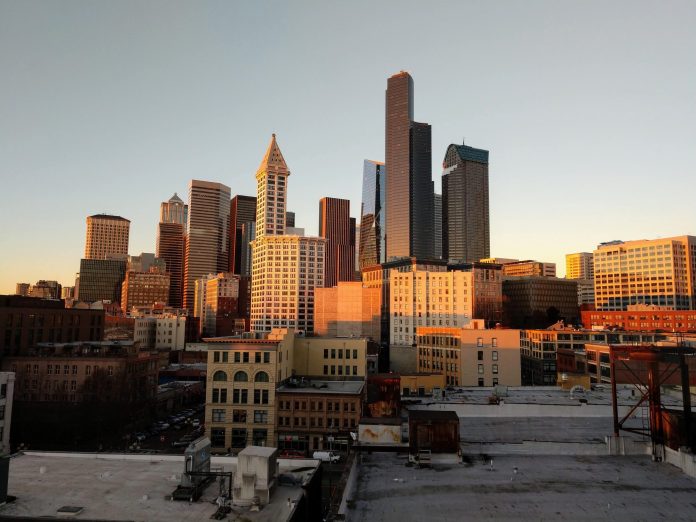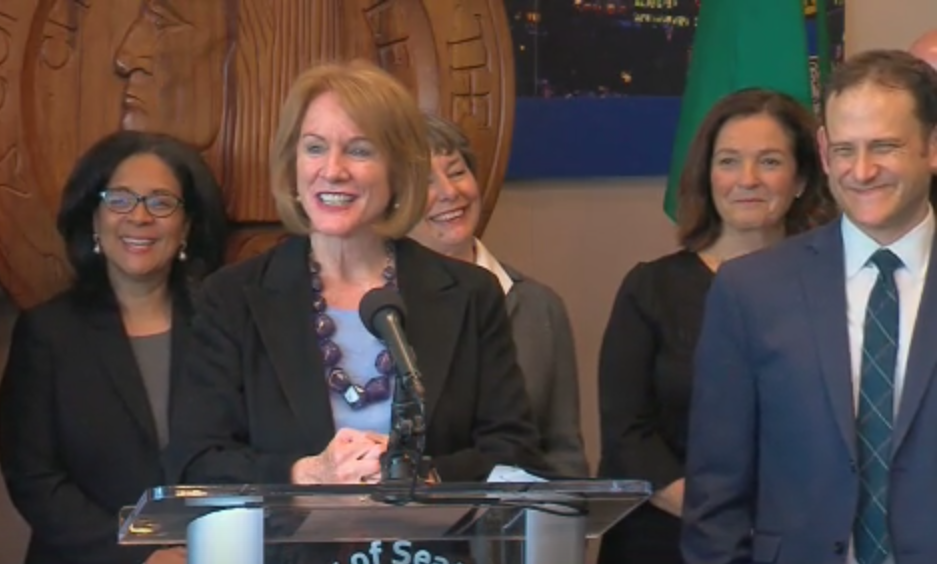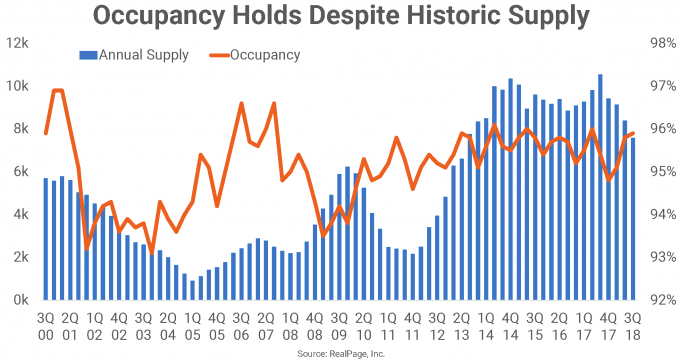
As 2018 draws to an end, it’s the time for reflection and last ditch efforts to get you to read some of fine volunteer journalism this year. 2018 was a year of setbacks, but also of groundwork laid.
It was Mayor Jenny Durkan first full year in office. Spoiler Alert: We gave her a D and some of our 2019 recap will illuminate why.
But first some good news: Democrats seized control of the U.S. House of Representatives during midterm elections, and Washington Democrats also expanded their majorities in Olympia, but failed to pass a carbon fee to fund green infrastructure. On the bright side, the carbon fee initiative, I-1631, did garner 57.8% of the vote in King County, suggesting Washington’s most populous county is ready to do something ambitious about climate.
On the smoky side, another punishing wildfire season in 2018 demonstrated climate action is more sorely needed than ever, and to urbanists like us that means housing reform, more people walking, biking and riding transit, fewer owning cars, and bolder action than Mayor Durkan has yet proposed.
There was also some bright spots on housing advocacy. In fact, Mike Eliason broke down how it was the year of the pro-housing advocate, so read his take for a housing-focused journey through 2018.
The Year of Four SDOT Heads
Meanwhile, the Seattle Department of Transportation (SDOT) delayed and/or scaled back ambitious plans on multiple fronts–projects intended to move people by means other than the most carbon-intensive method: the single occupancy vehicle. Some observers traced the delays and miscues to a lack of permanent leadership at the agency.

While 2017 was the year of four mayors, 2018 was the year of four SDOT directors. Scott Kubly officially left the post on January 5th, and Mayor Durkan tapped Goran Sparrman to fill in as interim director, but didn’t have a permanent replacement ready when Sparrman left the post in September to take a job with engineering megafirm HNTB. Instead, Mayor Durkan lured Linea Laird away from her position as project manager on the SR-99 viaduct replacement tunnel at the Washington State Department of Transportation (WSDOT) to serve as interim SDOT director. Finally, on December 19th, Mayor Durkan announced her selection of Sam Zimbabwe for permanent SDOT director. Zimbabwe was Chief Project Delivery Officer at Washington D.C. Department of Transportation and was considered a rising star, which has raised hopes he will jumpstart the stalled department.
The gap in permanent leadership came at a particularly sensitive time as Seattle readied itself for the Alaskan Way Viaduct closure and the ensuing transportation difficulties dubbed the “Seattle Squeeze.” Basically the next two to four years are likely going to be particularly heinous for commuters and we should have done more to prepare.
Streetcar Agony

No decision weighed heavier than the Center City Connector streetcar project, which will connect the South Lake Union and First Hill streetcars to make a much more useful line. Mayor Durkan halted construction on the project in March, even as utility work continued, citing budgetary concerns. In July, the mayor upped the ante by publicizing ‘will it fit the tracks’ concerns during a July 5th KUOW interview and later in her blog. Mayor Durkan still hasn’t released an answer to her own question–insisting on an outside engineering audit that is dragging on into its fifth month and flowing out like molasses from the first independent audit released after a delay of its own in September. KPMG, the City’s highly-paid consultant, confirmed SDOT’s ridership forecasts: Seattle’s streetcar system could well surpass 20,000 daily streetcar riders with the center city extension. Moreover, the streetcar farebox recovery rate is projected to exceed 52%, much higher than the county’s bus routes, which averages about half that. Through it all, the case for the center city streetcar remains strong, but the mayor still has yet to take the project out of purgatory.
Bike Network Delays
The streetcar project wasn’t the only to face extra scrutiny. 2018 saw several ready-to-go protected bike lane projects mothballed. 35th Ave NE was the most dramatic; bike lane opponents sabotaged City equipment with fireworks and the mayor’s reaction was ‘let’s hear out these reasonable people.’ The mayor hired a mediator hoping to defuse the situation or at least buy some time, but setting a dangerous appeasement precedent in the process. Unfortunately, mediation proved ineffective at getting people who hate bike lanes to stop doing so. City officials had told bike advocates to expect a decision by Christmas, but that deadline was also missed and the project remains in purgatory alongside the streetcar.
The bike and Vision Zero safety project delays spanned the whole year.
In January, SDOT shelved the important Fauntleroy Boulevard safety project (which included protected bike lanes) just months before construction was scheduled to begin. In April, we learned 35th Avenue SW safety project was not getting extended as planned, leaving a dangerous design rather than a rechannelized, slimmed-down version for this the fourth-most dangerous street in the city. Ditto for 24th Avenue where a dangerous four lane design did not get a rechannelization like 23rd Avenue previously did to the south.
We argued the time to remake 4th Avenue is now, adding protected bike lanes to fill out the basic bike network, but the Mayor’s Office nixed 4th Avenue protected bike lanes (and Pike/Pike and 9th Avenue, too) until 2021, hoping the Seattle Squeeze would be less squeezed by then and that one extra general purpose lane would somehow alleviate the congestion. This prompted the Seattle City Council to pass a resolution seeking to speed up those timelines. Finally in November, SDOT shelved another shovel-ready project in N 40th Street was shelved so SDOT could appease a few angry neighbors.
Taken for a (Rapid)Ride
But wait there’s more. 2018 was also the year we learned three of the seven RapidRide lines promised in the $930 million Move Seattle Levy passed in 2015 would not exactly be RapidRide. Due to rising costs and a shortage of partner funding, Routes 40, 44, and 48 will have to settle for lesser upgrades. The four RapidRide lines that remain will not be delivered as soon as initially pledged.
Head Tax Hijinx
The backtracking was not on transit alone. The Seattle City Council passed a bold plan to reinstate the employee hours tax (or head tax) in order to fund affordable housing and homelessness services with a steady stream of $50 million per year. Threatening a veto and saying she could pacify Amazon, Mayor Durkan had gotten the city council to add a five-year sunset clause and to shrink the package from $75 million per year it originally would have brought in.
Amazon and their chamber of commerce brethren flipped out anyway and poured hundreds of thousands in a repeal campaign run by conservative operatives. The city council and mayor backed down immediately and repealed the tax. As King County’s homeless count climbed to a new high, surpassing 12,000 in 2018, the additional revenue was desperately needed and could have been put to good use. Instead the Seattle Chamber of Commerce has been pushing budget efficiencies and upzoning as sufficient solutions to the region’s massive housing gap of approximately 30,000 homes for lower-income residents.
HQ2: Amazon Flexes Political Muscle
The whole head tax saga had the business booster crowd wringing their hands about how Seattle needs to get kissing corporate buttocks a lot more vigorously. Some pointed to the HQ2 contest in which Amazon selected a secondary headquarters through a hunger-games style contest, starting with just about every major city in America, and whittling down to twenty, and announcing in dramatic fashion that it was splitting the baby between two winners in New York City and Northern Virginia, dashing hopes that Amazon would revitalize the Rust Belt with its selection and instead opting for probably the most advantageous locations before the contest even began, but using the competition to exact billions in corporate giveaways. Not surprising given one of Amazon’s signature innovations has been avoiding taxation.
Housing Market Slowdown
Bluster of its empty threat to leave Seattle aside, Amazon did slow down its rate of hiring within the city. That slower hiring helped contribute to a respite from the nation-leading housing price increases Seattle had been seeing. In fact, for-sale homes actually saw a decrease in sell prices from the high of $751,000 attained in May by Zillow’s calculation.
Apartment Boom Continues
Another factor helping Seattle rents come down is the Seattle apartment building boom. After a banner construction year in 2017, Seattle’s apartment boom continued mostly unabated with most homes in downtown towers and large complexes in the city’s urban villages. Scant few new homes are being added in single-family neighborhoods.

Housing Reform Roadblocks
That said, efforts to broaden the boom beyond the downtown core and designated urban villages were hit with roadblocks during 2018. Legislation to liberalize backyard cottage rules is tied up in multiple appeals by Marty Kaplan arguing backyaed cottagea would ruin neighborhood character, despite the City’s environmental impact statement showing that reform would actually decrease the rate of tear downs while increasing housing options within single-family zones. Anti-housing homeowner groups also delayed for the entirety of 2018 long-planned Mandatory Housing Affordability (MHA) rezones for all of Seattle’s yet-to-be-rezoned urban villages.
Housing Reform Opportunities

The good news is the City scored a major victory in a November Hearing Examiner ruling, making MHA passage by mid-2019 seem within reach. For housing advocates inspired by bold citywide rezones in Minneapolis, this would also clear the way to go even further and end the apartment ban and make missing middle housing legal citywide. More good news: the City succeeded in passing parking reform in April, which will make make missing middle housing much more buildable, not to mention eco-friendly.
Lynnwood Link Avoids Federal Sabotage
Another bit of good news that came late in the year was that the Federal Transit Administration (FTA) had approved a $1.17 billion in Lynnwood Link grant, ending the cloud of uncertainty surrounding the project. With the federal money ensured, light rail will extended to Lynnwood in 2024. More importantly, it showed that the FTA, even under a troll-in-chief, will still more or less function and disperse grants eventually, which should ensure Sound Transit’s other light rail projects can chug along mostly on schedule.
Move All Seattle Sustainably Campaign Launch
2018 also saw campaign launch that could have a big impact in 2019 and beyond. On a personal note, The Urbanist co-founded, along with about ten groups, the Move All Seattle Sustainably (MASS) coalition dedicated to fighting for people walking, biking, and riding transit amidst the crisis of the Seattle Squeeze. MASS is building pressure on the City to add bus lanes, bike lanes, and safer traffic signals to ensure people can get around when gridlock strikes. Moreover, these efforts would help reverse the trend of increasing pedestrian fatalities on our streets.
Council Campaigns Lift Off
Dozens of candidates also jumped into Seattle City Council races before year’s ends with seven seats up for grabs. Already Councilmembers Rob Johnson and Sally Bagshaw have announced their retirement, leading to a rush of candidates entering those races. Socialist/urbanist Shaun Scott and Alex Pedersen on the opposite ‘let’s cater to wealthy homeowners spectrum’ have entered the race for Johnson’s seat. More candidates are surely on the way. Suffice to say, it’s going to be a very eventful 2019 as well.
Doug Trumm is publisher of The Urbanist. An Urbanist writer since 2015, he dreams of pedestrian streets, bus lanes, and a mass-timber building spree to end our housing crisis. He graduated from the Evans School of Public Policy and Governance at the University of Washington in 2019. He lives in Seattle's Fremont neighborhood and loves to explore the city by foot and by bike.

